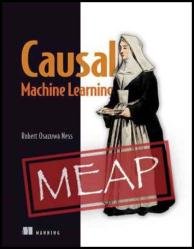Causal Machine Learning (MEAP v3)
- Добавил: literator
- Дата: 13-01-2023, 18:26
- Комментариев: 0
 Название: Causal Machine Learning (MEAP v3)
Название: Causal Machine Learning (MEAP v3)Автор: Robert Osazuwa Ness
Издательство: Manning Publications
Год: 2022
Страниц: 187
Язык: английский
Формат: pdf, epub
Размер: 10.1 MB
How do you know what might have happened, had you done things differently? Causal machine learning gives you the insight you need to make predictions and control outcomes based on causal relationships instead of pure correlation, so you can make precise and timely interventions.
In Causal Machine Learning you will learn how to:
Build causal reinforcement learning algorithms
Implement causal inference with modern probabilistic machine tools such as PyTorch and Pyro
Compare and contrast statistical and econometric methods for causal inference
Set up algorithms for attribution, credit assignment, and explanation
Convert domain expertise into explainable causal models
Causal Machine Learning is a practical introduction to building AI models that can reason about causality. Author Robert Ness, a leading researcher in causal AI at Microsoft Research, brings his unique expertise to this cutting-edge guide. His clear, code-first approach explains essential details of causal machine learning that are hidden in academic papers. Everything you learn can be easily and effectively applied to industry challenges, from building explainable causal models to predicting counterfactual outcomes.
about the technology
Causal machine learning is a major milestone in machine learning, allowing AI models to make accurate predictions based on causes rather than just correlations. Causal techniques help you make models that are more robust, explainable, and fair, and have a wide range of applications, from improving recommendation engines to perfecting self-driving cars.
about the book
Causal Machine Learning teaches you how to build machine learning and deep learning models that implement causal reasoning. Discover why leading AI engineers are so excited by causal reasoning, and develop a high-level understanding of this next major trend in AI. New techniques are demonstrated with example models for solving industry-relevant problems. You’ll learn about causality for recommendations; causal modeling of online conversions; and uplift, attribution, and churn modeling. Each technique is tested against a common set of problems, data, and Python libraries, so you can compare and contrast which will work best for you.
Скачать Causal Machine Learning (MEAP V03)
Внимание
Уважаемый посетитель, Вы зашли на сайт как незарегистрированный пользователь.
Мы рекомендуем Вам зарегистрироваться либо войти на сайт под своим именем.
Уважаемый посетитель, Вы зашли на сайт как незарегистрированный пользователь.
Мы рекомендуем Вам зарегистрироваться либо войти на сайт под своим именем.
Информация
Посетители, находящиеся в группе Гости, не могут оставлять комментарии к данной публикации.
Посетители, находящиеся в группе Гости, не могут оставлять комментарии к данной публикации.
